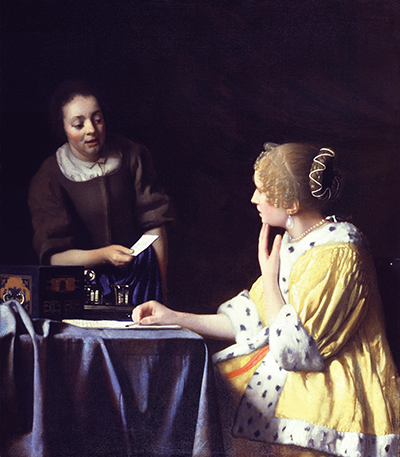Mistress and Maid dates back to 1667 around the middle of the artist's career as he had found his way of achieving artistic mastery during the Dutch Golden Age.
A reviving artwork that illustrates Johannes Vermeer's growth in technique and visualization as the renaissance artist revisits a past scene in a new light.
This artwork showcases a woman with who is stated to be a maid as they exchange a few words and actions. The woman is seated at a desk as he right hand gently touches a pencil that lays on a beige piece of paper.
The artwork incredibly resembles Vermeer's previous artwork A Lady Writing, which illustrates a woman in the same yellow jacket writing at a table. Mistress and Maid carries the same context to the other painting however is much more evolved. It is debated that the woman in Mistress and Maid is the older version of A Lady Writing.
As the woman within the artwork is seated at a table as she writes a letter, she glances at her maid as her mouth opens slightly. Her right hand touches the bottom of her open mouth as if she is in shock of the words of the maid. The maid gently leans towards the woman as she hands her a white letter as her mouth opens preparing to state something.
The mistress is in shock of the act as it is most likely a letter she has been expecting for a while. Vermeer was a brilliant artist as he was able to depict a story ever so simply through the events that are occurring within the piece.
The woman is dressed within a light yellow dress with an orange strap that falls down the dress. The outfit is faired with a matching yellow jacket with a white fur collar and sleeves.
This bright set seizes the viewers' attention as she holds the focal point of the frame. Alongside, the attire of the woman prevails her wealth and upper class position as she has a maid who works for her. The attention of the painting is initially brought to the woman in yellow, up raising the question of why the woman is referred to as a mistress.
The hairstyle of the woman has been well seen throughout other one's of Vermeer's portraits as the woman is believed to be his wife, Catharina.
Her light blonde hair is popularly placed upwards in a tight bun as the rest flows out the sides of her face in light curls. The wealth of the woman is infused as she wears a white pearl necklace paired with matching dangling earrings. The table at which the woman is seated at is covered in a dark blue tablecloth that adds a larger variety of colour to the painting.
The maid is dressed in a simple brown dress with a clean-cut white collar. The woman holds older features with rosy cheeks and dark hair, which blends into the background of the painting. Vermeer had painted the background of the painting in a harsh black colour, not showcasing a glimpse of colour.
This darkened presence adds a deeper feel within the painting while not over powering the focal point of the woman and her maid. Vermeer held impeccable artistry in the knowledge of how to use different colours to accentuate one another rather than hindering the quality of the work.
The darker colours throughout the artwork add to this element as the yellow draws in the attention of the viewer while still being able to achieve a positive emotion to it.




